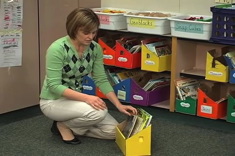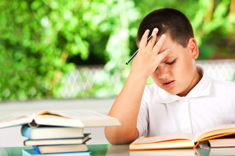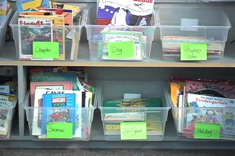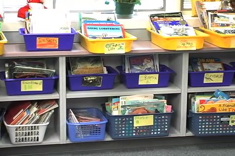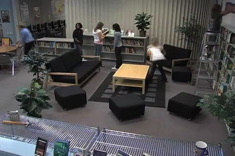You could say teaching is in my blood . . . literally. There is a long line of teachers in my family. My mom is a reading support teacher, and I have a sister who is an art teacher. Another sister is halfway through the process of becoming a middle school teacher. I also have seven aunts with teaching experiences that include elementary, high school math, technology, English language learners and curriculum support. Maybe we were influenced by both of my grandmothers — one who taught kindergarten, and the other biology.
If you come from a family of teachers, you might imagine the conversations we have when we see each other on vacation or at family reunions. We easily wrap ourselves in talk about the newest, best professional books, blogs, ideas and books for the classroom. Our “teacher talk” usually subsides when a non-teacher in the family begins teasing us about our classroom obsessions.
I have shared all this with you because my mom, the K-3 reading support teacher, has decided to change the look of her classroom library. I know that the conversations we have as a family of teachers are just a small piece of why she is experimenting with the change in her classroom. I decided to ask her about the changes she wanted to make so that I could help her in reorganizing her library. These are good starting points for any colleague or coach to use when they are helping a teacher make changes to a space that isn’t working as well as it could in their classroom.
What is your reason for wanting to make changes in your classroom?
Sometimes I need help getting struggling readers out of leveled books. They need to take more risks, and I realized that they weren’t growing as much with just leveled books. I found that kids in my program often had only looked at books with levels in mind. I caught them constantly questioning themselves, “Can I read this level?” when they would go to choose a book independently. Because the majority of work I do with my students has been with leveled books, there was something missing. I didn’t feel kids were interested or having as much fun with reading as they should.
What are you struggling with in your own library space?
After talking with you about newer books like Elephants Cannot Dance! and the Mercy Watson series, I read these books with my students. The books changed things for me. Now I am struggling with the limited space I have for all my books. I am wondering what I should do with my read alouds and picture books that I use after guided reading lessons.
You talked about read alouds. I know you have a small window of time for meeting with students on a daily basis. How do the read alouds work into your program?
For my second and third graders I use five minutes every day to read aloud (a longer text) to them. There are some days when the schedule changes, and I don’t have time for read aloud, but I know how much they enjoy it. I have noticed a huge change in the way kids comprehend by asking questions, connecting and just enjoying a story. I sometimes have copies of the read aloud available for independent reading time.
What do you feel successful with in your space?
I have a rolling cart that has enough spaces for each one of my grade level groups. I organize the guided reading books, writing notebooks, and any supplies like dry erase boards that I might need to grab quickly on the cart. I have spent a lot of time making sure the guided reading books are organized in boxes according to reading level. This helps me grab what I need quickly when planning for a group.
A Plan for Reorganizing
With my mom’s needs in mind, we began to reorganize her space. I think we both felt overwhelmed sorting through 17 years of resources, files, books, and supplies that she had compiled in her small trailer. Here are some of the strategies we used to accomplish her goals:
1. Clean Out Untouched Books
One of the first things I asked her to do was to sort through her picture books and early readers. She struggled and repeatedly said, “This is hard.” We decided that if she hadn’t used the book in a minilesson or it wasn’t in student hands over the past two years, it was time to get rid of it. I found myself reminding her of what we decided, and those gentle reminders allowed her to say goodbye to books that had sat untouched on her shelves for years.
2. Sort Books into Baskets
After culling unread books, we sorted the piles of remaining books into baskets. To do this, we first talked about how the picture books are used, which ones students like best, and what kind of stories were available. Books were most often used to connect to a minilesson introduced during guided reading — usually the day after a lesson. With first graders, picture books that contain many illustrations or have a repeated high frequency word are the ones used most often. This helped us start baskets we called “Let’s Begin to Read” and “Books with Repeating Words.”
We also created baskets that would appeal to young students, including “Silly and Scary Books” as well as “Dog and Cat Books.” I noticed many fairy tales, rhyming books and song books, so I created areas in her slotted bookshelf for these. Categorizing books in these baskets helped us find a place for many. We talked about showing students the value in caring for, using and understanding the classroom library during “Library Day ” — a regular time of choice and exploration in the schedule that encourages students to browse and select books independently.
3. Making Spaces for Kids
After the books were organized, we began to create open spaces for kids to independently find books and sit on the floor. As we did this, we cleared the entry to the room and set up shelves of books along the walls. We decided that we had to move a bookshelf that was covering the window. And though the only place we could find for it covered a bulletin board (that often goes unused), we felt natural light was a must. We replaced file-filled shelves with baskets of picture books, added lamps to soften spaces with lights, and placed the metal file cabinet sideways against the wall so magnetic book channels could be added to show off new books.
4. Labeling Baskets
One of the last tasks was to create labels for her baskets of books. We took time to flip through the titles in each basket together, since I did most of the initial sorting while she made decisions about which books to keep or give away. We decided to keep possible read alouds in a stack on the tall file cabinet next to the lamp. We also decided to create a basket for books that had a family theme and a basket for a variety of books (Henry and Mudge; Annie and Snowball and the Dress-up Birthday
etc.) suitable for transitional readers which we labeled Early Readers.
After two days in this small space, we accomplished a lot. Yet we also couldn’t stop thinking about how picture icons on the baskets would help the kids return the books, beanbags would be nice to have for reading choice time, and maybe a couple rugs would help define her specific areas in the room. It seems that there is always something we can do to enhance our classroom space. What we are both most excited about is the reaction of the students. I had my own classroom to return to, but how I wished I could have been a fly on the wall when students saw the reorganized space for the first time.

